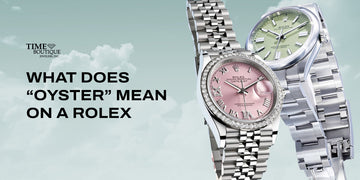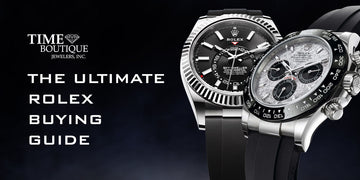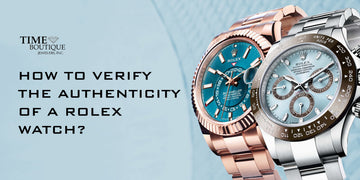
You’ve likely seen “Oyster Perpetual” on almost every Rolex watch. But what does “Oyster” really mean? And why is it called “Perpetual”? Simply put, “Oyster” refers to the watch’s water-resistant case, and “Perpetual” means it has an automatic self-winding movement. These features come from a lot of Rolex innovation and technology.
In this article, we’ll explain what “Oyster” means on a Rolex watch and why the term is so important.
What is a Rolex Oyster?
“Oyster” is Rolex’s name for their water-resistant watch case, including the crown and caseback. Back in 1926, just about 20 years after Rolex was founded, the company introduced its first waterproof watch, inspired by the oyster shell.
Think about how an oyster shell stays tightly closed in the water or how tough it can be to get to the meat inside—this idea reflects the watch’s ability to keep water out.
Here are a few key points about the Oyster case:
1. The Oyster case featured a screw-down bezel, case back, and crown, which guaranteed real water resistance, just like Rolex promised. Later on, the screw-in bezels were replaced with press-fit and snap-on versions, and by around 1945, the original “3-piece” Oyster case design was mostly phased out.
2. Hans Wilsdorf, Rolex’s founder and a brilliant marketer, made sure everyone knew about this innovation. One famous publicity stunt was when Mercedes Gleitze swam across the English Channel in 1927 while wearing a Rolex Oyster around her neck.
3. Rolex secured a patent (CH114948A) for their water-resistant Oyster watches, invented by Georges Perret and Paul Perregaux (no relation to Girard-Perregaux). This patent helped establish Rolex as a pioneer in waterproof watch technology.
Even today, Rolex continues to push the limits of water resistance. In 2023, they launched the Deepsea Challenge, a watch designed to withstand the deepest parts of the ocean, showing that few brands can match Rolex in this area.
What is a Rolex Oyster Perpetual?
Any Rolex Oyster watch with automatic winding is called a Rolex Oyster Perpetual. While the Oyster case was a major breakthrough, it wasn’t truly complete until 1931 when the Oyster Perpetual was introduced. In Rolex terms, “Perpetual” means a mechanical watch with automatic winding, not to be confused with a perpetual calendar, which is a different and more complex feature that wasn’t common in the early 1900s.
One issue with the screw-down crown on early watches was that winding the watch every day meant constantly screwing and unscrewing the crown, which could wear out or damage the threads over time. This problem led to innovations like Panerai’s famous crown-guard, which was designed to protect the crown while maintaining water resistance.
Early Panerai watches, which used Rolex Oyster cases and were made for Italian Navy divers, added this “Tight Seal Device” in 1955 to prevent water damage caused by frequent winding, likely because automatic movements were too expensive for them at the time.
Hans Wilsdorf, Rolex’s founder, had already recognized the importance of automatic winding and had been working to create a self-winding Oyster watch since the original Oyster was launched. After some trial and error, the Rolex Oyster Perpetual was finally introduced in 1931. This watch combines two key features: water resistance (“Oyster”) and automatic winding (“Perpetual”).
The Oyster Perpetual is one of Rolex’s longest-running models but also one of the oldest-named wristwatch models, rivaled by only a few brands like Cartier. It represents Rolex's core identity—almost all of its iconic watches are based on the Oyster Perpetual’s foundation, and you’ll see “Oyster Perpetual” proudly displayed on their dials.
Was the Rolex Oyster the First Waterproof Watch?
Not exactly. There’s a common belief that the Rolex Oyster was the world’s first waterproof watch, but that’s more of a myth. The Oyster was likely the first waterproof watch designed for everyday use that didn’t rely on cork seals—Rolex used rubber instead.
The Oyster Perpetual was also the first automatic waterproof watch. For a deeper look into the history and to clear up Rolex’s “first waterproof watch” claims, you can check out Stan Czubernat’s book. In fact, the Oyster wasn’t even Rolex’s first waterproof watch.
Back in 1922, they made an early and rather bulky model called the “Submarine.” While it was less practical, it paved the way for the more refined Oyster. And it’s fair to say the Oyster looks much more elegant than earlier waterproof watches like the Depollier.
Do All Rolex Oysters Have Screw-Down Crowns?
Since 1954, every Rolex Oyster has featured a screw-down crown. There was a brief exception in 1952-1953 when Rolex made some “Super Oyster” crowns that didn’t screw down, but those were the odd ones out. Aside from that, all Oyster models have the screw-down crown for reliable water resistance.
Is Every Rolex an Oyster Perpetual?
Most Rolex watches—including all the modern sports models—are Oyster Perpetuals, but there are some exceptions.
-
Neither Oyster nor Perpetual: These are usually vintage dress watches. While not Rolex’s primary focus, they do exist.
-
Perpetual but not Oyster: The current 1908 collection (and the earlier 39mm Cellini series) features automatic movements but doesn’t have the Oyster water-resistant case. There are also a few rare vintage dressy Perpetual models without Oyster cases.
-
Oyster but not Perpetual: Some older manual-wind waterproof watches, like the 4-digit Daytona or early entry-level Oyster models, fall into this category. Rolex stopped making these by the late 1980s.
Conclusion
The Rolex Oyster Perpetual is a symbol of innovation. It combines water resistance with automatic winding to create a timeless and reliable watch. Whether you're a seasoned collector or new to luxury watches, understanding these key features helps you appreciate what makes Rolex so special.
At TB Jewelers, we’re here to help you find the perfect Rolex Oyster Perpetual or answer any questions you have about these iconic timepieces.
Contact us today to explore our collection or get expert advice!
Frequently Asked Questions (FAQs)
1. Are all Rolex Oyster watches automatic?
Most modern ones are, but some older Oyster models were manual-wind.
2. What makes the Rolex Oyster Perpetual different from other Rolex models?
The Oyster Perpetual is the foundation model featuring the waterproof case and automatic movement, while other models may add extra complications or design features.
3. How often should an Oyster Perpetual be serviced to maintain its performance?
Rolex recommends servicing approximately every 5-10 years, depending on usage.
4. What are some iconic Rolex models built on the Oyster Perpetual foundation?
Models like the Submariner, Datejust, and Explorer all evolved from the Oyster Perpetual design.
5. Can the Oyster Perpetual handle extreme conditions?
Yes, thanks to its robust case and movement, it’s designed to perform well under a variety of conditions.




